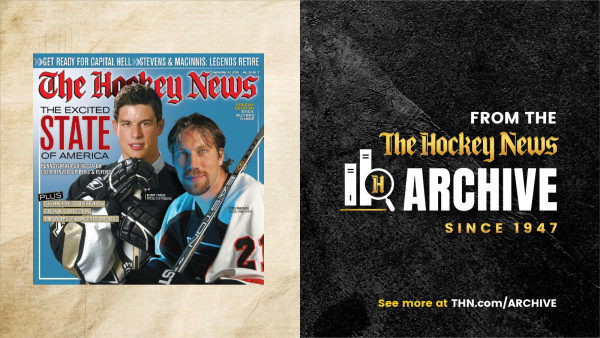
Archive: How Jarome Iginla Built a Better Hockey Body During the NHL Lockout
Like all NHLers, hockey legend Jarome Iginla had lessons to learn about diet and conditioning. The full-season NHL lockout actually helped Iginla improve on that front.

Jarome Iginla’s son, Tij Iginla, was a top pick of the Utah Hockey Club in the first round of this year’s NHL draft. But in this major feature from The Hockey News’ Sept. 20, 2005 edition (Volume 59, Issue 3), writer Ryan Kennedy spoke to Iginla and popular hockey trainers about building their physique to handle the rigors of the NHL game.
(Here’s a friendly reminder: to access The Hockey News Archive, visit THN.com/Free and subscribe to the magazine.)
Jarome Iginla was one of hockey’s most ferocious competitors, but he had to learn how to use his physicality to his advantage as he battled opponents for the puck night in and night out.
“I was in great aerobic shape, but (lacked) a lot of explosion,” Iginla told Kennedy. “If you’re battling with a D-man, it’s who tires out first. That half-step can make the difference between getting a scoring chance or not.”
For longtime trainer Charles Poliquin, and for most trainers, an athlete’s diet goes a long way toward dictating their success levels.
“Body fat is the best predictor to determine training camp (condition),” Poliquin said. The ideal body fat rate for an NHLer is 10 percent, and every percentage point either way has an exponential effect. “Al MacInnis had six-and-a-half percent,” Poliquin said. “He played a long time, and hard.”
TRAINING: BUILDING A HOCKEY BODY
Vol. 59, No. 3, Sept. 20, 2005
By Ryan Kennedy
When Calgary Flames star Jarome Iginla got really serious about hockey, he was 15 years old and willing to make sacrifices. In order to get an NHL body, he did weight training and put on some pounds. Years later, Iginla knows it isn’t just the bulk that makes you a pro.
“My heart was in the right place,” Iginla said. “To be honest, I didn’t know how to train.”
With a full year off due to the lockout, Iginla kept himself in game shape with an off-ice training regiment that focused specifically on hockey skills. “I was in great aerobic shape, but (lacked) a lot of explosion,” he said.
It’s that type of explosive speed that is crucial for, say, beating a defenseman to a puck that squirts out of the corner. “If you’re battling with a D-man, it’s who tires out first,” Iginla said. “That half-step can make the difference between getting a scoring chance or not.”
Iginla recently helped launch a Nike hockey training program alongside his trainer Rich Hesketh and Vancouver Canucks star Markus Naslund. The campaign focuses on hockey-specific off-ice exercises.
The lockout-induced rest helped Iginla – the sniper was able to work certain parts of his body while resting others. “I would do upper body, take a month off my legs and vice versa,” he said.
T.R. Goodman, owner of Pro Camp Sports in California, spent his summer training NHL all-stars such as Mario Lemieux, Rob Blake and Glen Murray, and said the time off did wonders for those who were ailing. “We tried to get the trauma out of their bodies,” Goodman said. “You could see the range of motion in their bodies was much better.”
But building the perfect hockey player is about more than just exercise. For trainer Charles Poliquin, the man who resurrected Gary Roberts from his career-threatening neck injury, diet is a key element for post-lockout players.
“Body fat is the best predictor to determine training camp (shape),” Poliquin said. The ideal body fat rate for an NHLer is 10 per cent, and every percentage point either way has an exponential effect. “Al MacInnis had six-and-a-half per cent,” Poliquin said. “He played a long time, and hard.”
Not only does body fat slow you down, but going to training camp out of shape can be dangerous. “Give me four months of strength training and you’ll never have a groin pull,” Poliquin said. “The porky pigs are the classic injury guys.”
The Hockey News Archive is a vault of more than 2,640 issues and more than 156,000 articles exclusively for subscribers, chronicling the complete history of The Hockey News from 1947 until today. Visit the archive at THN.com/archive and subscribe today at subscribe.thehockeynews.com

